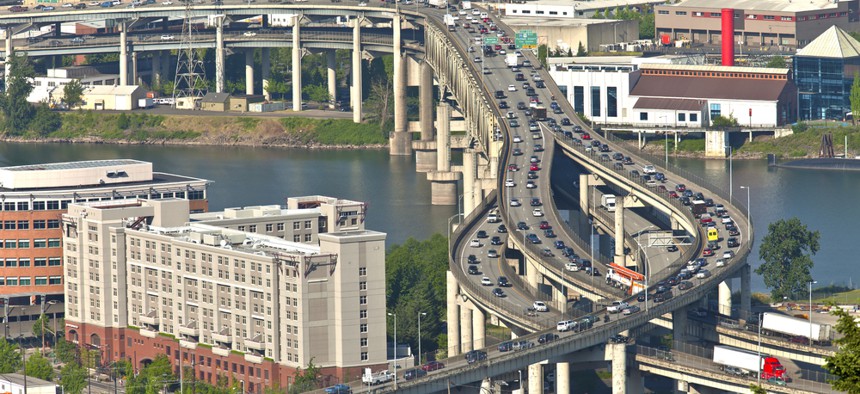Oregon's Pay-Per-Mile Road-Funding Program Continues to Evolve

A highway interchange south of downtown Portland, Oregon. Shutterstock
The Beaver State's pilot project could change how Americans think about the cost of driving.
We've seen this movie before, where Congress heads straight toward a transportation funding cliff it totally saw coming , so we know that lawmakers will find some awkward-and-unnecessarily-dramatic way to stop at the edge. That's great for all the jobs spared in the short term, but bad for the hope of learning any long-term lessons. Because the real danger is not this fiscal cliff, but the massive funding sinkhole coming to take car and cliff alike; here's Senator Orrin Hatch, via The Hill :
"I think we'll resolve this problem," Hatch said. "But the big problem is, what do we do about the approximately $100 billion we really need to raise in the future? And we're going to have to come up with a way of doing that."
In case you're new here, the recurring problem in federal transportation funding is the increasingly puny power of the gas tax that populates the Highway Trust Fund. That tax hasn't moved since 1993 despite inflation, a reduction in driving mileage, a massive spike in construction costs, and increased fuel efficiency, among other nationwide changes. The fund is fundamentally broken and desperate for a replacement instead of a quick fix.
There's a case to be made that the federal government should get out of the transportation funding business entirely. Assuming nothing that radical will occur, the best short-term solution is to index the gas tax to inflation and construction costs , but that still leaves the (good) problem of increased fuel-efficiency. So the best long-term solution is to find a more direct way to charge Americans for the damage they cause to highways, rather than continue charging them indirectly via fuel costs.
Enter Oregon's evolving pay-per-mile road funding program. A new report from the Oregon DOT summarizes the policy steps that took the state from the realization that the gas tax was not long for its treasury, back in 2001, to the passage and pending implementation of the country's first mileage-based funding system, in 2013 . Against a backdrop of 21 years of federal gas tax stagnation, 12 years of development looks like a bargain.
The beauty of Oregon's system is its flexibility. First is the way people pay. As Oregon learned over time, some people are scared to have government track all the mileage they drive. Fair enough. So the state offers five levels of mileage-based payment options, from a simple odometer reading to precise GPS monitoring via smartphones. There are benefits to the more invasive option—namely, the GPS knows when you're on private roads, which means you aren't charged for that mileage—but the point is that options exist to suit everyone's privacy tastes.
Then there's the flexibility of the system itself. Oregon's pilot system charged drivers 1.56 cents for every mile they drove, the idea being that cars place a direct stress on road infrastructure. But the fee rate can be adjusted to charge more money to heavy trucks that cause more damage to roads. Or it can be adjusted to charge more money for cars driving during rush-hour , serving as a congestion deterrent as well as a funding mechanism.
And, at the end of the day, the system seems to do a better job generating road funding than the gas tax does. Oregon reports that revenue under its pilot program exceeded expected gas tax earnings by 28 percent (and as fuel efficiency rises, the system would also stand to do relatively better):

While Oregon seems to be targeting fuel-efficient cars unfairly here, hybrid and electric vehicle drivers still benefit from lower fuel costs. The per-mileage funding discussion is about road damage, specifically, which all cars produce. So if everyone were to drive EVs, gasoline might become obsolete, but road damage wouldn't. (And, by extension, if people stopped driving entirely, and mileage revenues dipped, lawmakers would realize they don't need to build as many roads .)
But the greatest potential of Oregon's program is its ability to change the way Americans think about the cost of driving. Right now the cost of road maintenance is hidden in the price of fuel. In a mileage-based funding system, such as Oregon's, drivers would receive monthly statements showing their driving activity and road expenses. The entire funding system becomes more like a utility—like an electricity or cable bill—enabling people to adjust their behavior in response to their expenses.
In other words, people would think more proactively about their road consumption. Right now, like too many representatives in Washington, they don't.
This article originally ran on July 9, 2014, on CityLab .
( Image via Rigucci / Shutterstock.com )





